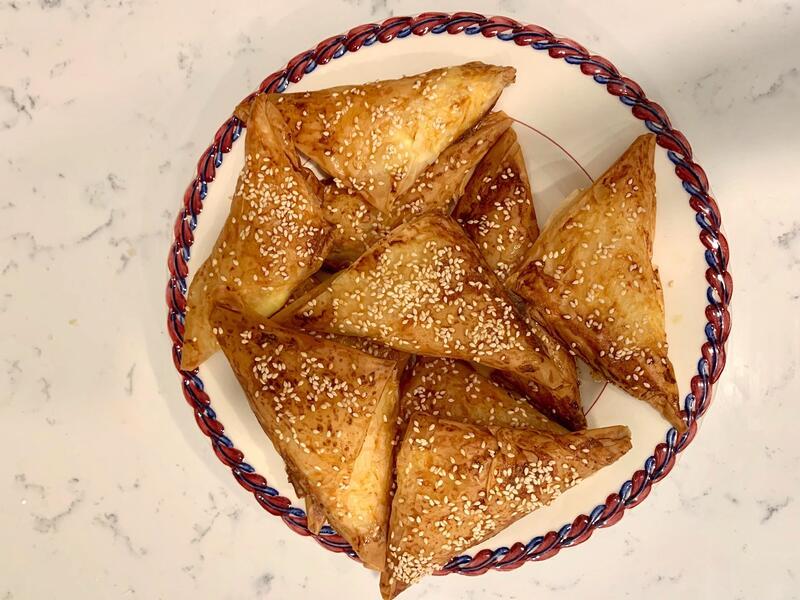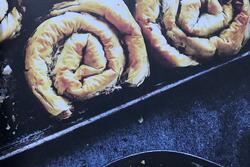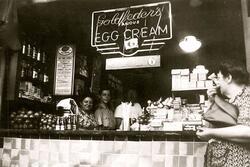Reclaiming the Kitchen as a Jewish, Feminist Space
For the past three weeks, I’ve made one Jew-ish recipe a day (virtually) alongside my friend, and fellow Rising Voices Fellowship alumna, Mica. Some of the foods we made were Jewish by tradition, such as challah and latkes, some Jewish by ancestry, such as shakshuka and bourekas, and some are questionable in their Jewishness, such as falafel and Israeli salad. A grand total of fifteen dishes from thirteen different recipes (challah was naturally a three-peat), these foods that have been prepared for centuries by Jewish women provided both insight into Judaic history and comfort in my present situation.
We began with bagels. With Mica on Facetime, my computer propped up against the back of my counter, we watched the Instagram highlight titled “Bagels” on the profile of user @greatjones. Despite the entire recipe being in grams, we managed to follow along with Daniela Moreira, of Call Your Mother, our favorite DC deli. While the history of bagels may be relatively straightforward—brought to America by Polish Jews, rose to popularity in New York City—the preparation was very involved and took two days. We prepped the dough on Monday and boiled and baked the bagels on Tuesday. To stay on schedule, we made rugelach, another Polish, Ashkenazi baked good, Tuesday afternoon. We used my mom’s recipe (sorry, no hyperlink here!). We followed up these two intensive days with Israeli salad, simple to prepare, but anything but simple in origin. Inspired by a text from my Sephardic childhood friend, my recipe involved iceberg lettuce in addition to the tomato, cucumber, and onions. Israeli salad predates the state of Israel and, thus, there is controversy over its name and origin, with many calling the dish an Arab salad or a Palestinian salad instead. Thursday, too, we made a food controversial in its Jewishness: falafel. It is true that Ashkenazi Jews in Israel did not invent falafel. However, Mizrachi Jews have been eating falafel for ages in Yemen, Iraq, Iran, Lebanon, Jordan, and Palestine, so falafel definitely has Jewish ties. To close out the week we, of course, made challah. We used Mica’s family recipe for this day-long process with delicious results.
Falafel and Israeli salad prompted two crucial questions during week one of our food journey: What makes a dish Jewish? And how do regional politics of the Middle East connect with and reflect in food? To the first question, we had absolutely no answer. We were making foods that have traditionally been cooked by Jews even if they didn’t directly originate that way. To the second question, we answer: pretty significantly. Anthony Bourdain argued that “there’s nothing more political than food,” a statement evidenced by the very names of certain dishes.
The following week, we cracked open Joan Nathan’s Jewish Cooking in America to make Georgian Fried Eggplant, Zucchini Parmesan Latkes, and Rotolo di Pasta con Spinaci. The eggplant dish was likely shared by Jewish merchants and itinerant rabbis traveling across Europe and Asia. According to Nathan’s description, we can trace this dish’s path from the Middle East to Italy to Georgia to Brighton Beach. The pasta dish, transcribed from the notebooks of Resy Guetta Luzzatto, comes from her husband, who belonged to one of the oldest Venetian Jewish families. These two dishes, while both connected to European Jews (and both delicious!) show opposite ends of the Jewish experience. The eggplant dish exists in its current form because of Jewish movement. It evolved because of the diasporic nature of the Jewish people; as the Jews moved and changed, this dish did too. The pasta, on the other hand, comes from the passing down of a family recipe l’dor vador in Jewish Italy. The Luzzattos have a deep history in Venice, dating back at least to Rabbi Simcha Luzzatto of the late sixteenth century. While it is the transient nature of contemporaneous Jews that caused the creation of the eggplant recipe, it is the Luzzatto family’s consistent documentation and still endurance that allowed the pasta recipe to end up in Nathan’s cookbook
The second week, we also made challah (again) and two other dishes that exist due to Jewish displacement: bourekas and shakshuka. Bourekas originated with Spanish Jews in Turkey who combined the Spanish empanada with the Turkish borek to create a cross-over dish—cheese-filled puff pastry—with a cross-over name. Shakshuka originated in the Middle East but exactly where is unknown: Some claim it originated in Yemen and others argue the Ottomon Empire. In any case, it was brought to Israel by North African Jews as a hearty and affordable dish. Between these two dishes and the Georgian eggplant recipe, we were offered a glimpse into the complicated nature of Jews claiming food when we’ve seldom been able to claim anything as truly our own.
Week three included the most labor-intensive dishes and, with them, an appreciation for our female ancestors. We began the week with Yemenite kubaneh bread, a traditional dish eaten by Yemeni Jews during the Sabbath. We rushed through the process, and it still took around four hours. Traditionally, the (female) Jews of Yemen would spend Friday making the kubaneh dough and let it rise and cook overnight, leaving it ready to eat mid-morning on Saturday. The next day, we made matzo ball soup using a hand-scrawled recipe on an index card from my great-grandmother, in which she instructs makers to use a “large fowl” and “some fresh parsley” for the broth. Babka was a project for Wednesday and Thursday. Though traditionally, the Polish Jews with whom this recipe originated would use extra challah for the dough, we made dough from scratch for a large portion of an afternoon. We closed out the week, again, with challah. All four of these dishes required most of the day (or two) to make, further evidence of the involvement required in their creation.
It is not lost on me that these foods come directly out of the labor of my female ancestors and other Jewesses. These women had no choice but to spend the whole day in the kitchen, and their confinement to cooking was part of a larger system barring women from society. It is because of these women that I, an eighteen-year-old, college-bound, proud Jewish feminist, am able to spend the better part of three weeks in the kitchen. It is through understanding the complicated origin of these dishes—be it regional conflict or displacement—and fostering an appreciation of my female ancestors that I am able to reclaim the kitchen as a Jewish feminist space.








I am hungry and inspired. Yay Emily!!!
does that include kashrut?
hi Emily
thanks for sharing and reminding me that I need to get back in the kitchen again soon.
Sandy